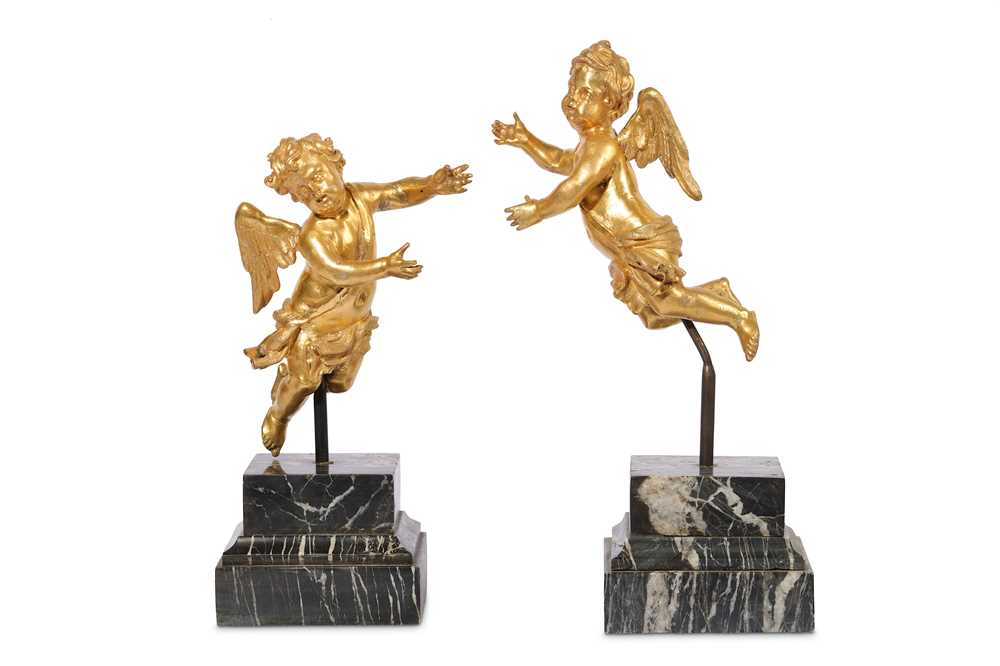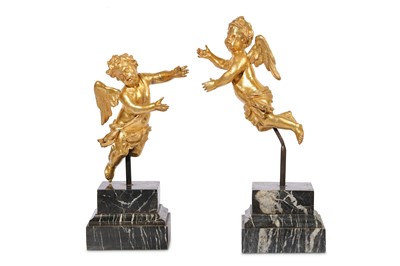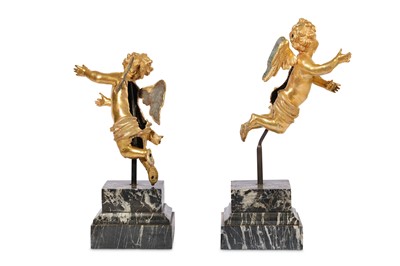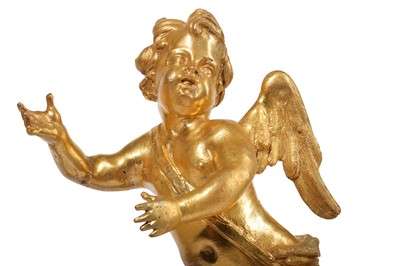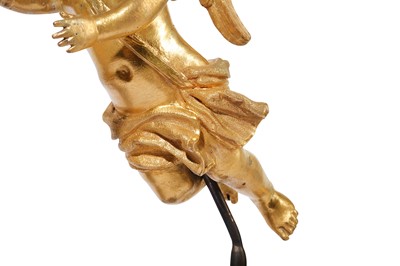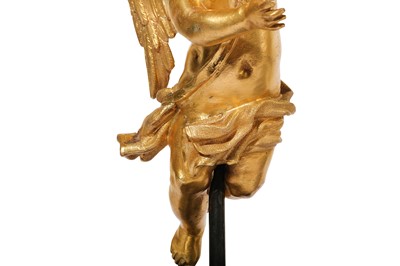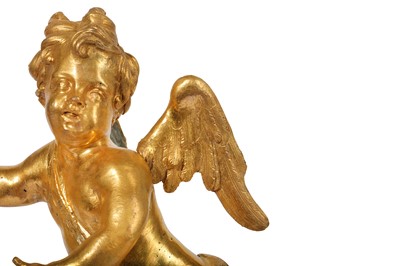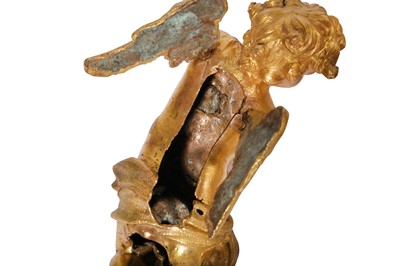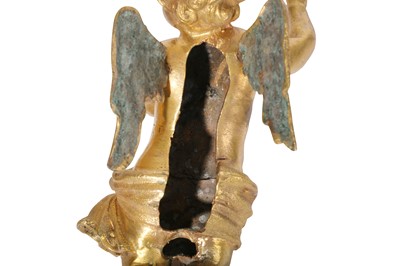12th Dec, 2019 10:00
Fine European Works of Art & Clocks
A PAIR OF SECOND HALF 17TH CENTURY ITALIAN (ROME) GILT BRONZE WINGED CHERUBS IN FLIGHT each wearing a sash securing flowing drapery, their wings separately cast and each secured with a single screw, their backs hollow, raised on later white veined, black marble, stepped square plinths, the putti 24cm high, 43.5 cm high overall (2) WITH THANKS TO DR CHARLES AVERY FOR ASSISTANCE WITH CATALOGUING THIS LOT.PROVENANCE:Property of a private collector, England RELATED LITERATURE:Alessandro Angelini, Gian Lorenzo Bernini e I Chigi tra Roma e Siena (Cinisello Balsamo, Milan 1998), p. 146, figs. 144-45;Boudon–Machuel, François du Quesnoy, 1597-1643, Paris 2005, pp. 141-46, figs 142-44 ; pp. 247-49, pls. Fig. 140;Oreste Ferrari and Serenita Papaldo, Le sculture del Seicento a Roma (Rome, 1999), p. 320;Jennifer Montagu, Gold, Silver and Bronze: Metal Sculpture of the Roman Baroque, (New Haven & London, 1996), pp. 12-13, fig. 18;Rudolph Wittkower, Gian Lorenzo Bernini, The Sculptor of the Baroque (London, 1966), pls. 44-45 NOTES: Properly speaking, Italian putti are spiritelli, or – in Shakespearian English – ‘sprites’, a concept that survives today only in the adjectival form of ‘sprightly’. They were the means by which messages were believed to be taken speedily round the body, for example from the heart to the hands, or eyes to the brain, which we know nowadays – more prosaically – are electrical impulses. There were thus myriad such useful, though invisible, little beings busy within the individual body and also in the atmosphere around people, conveying sights, sounds and ideas to and fro. They were normally envisaged as plump baby boys, derived from ancient Roman reliefs and statues, usually lightly clad or naked and often with wings, so that pagan images of Cupid could be confused with those of angels (cherubim). They were pioneered in early Renaissance art by Donatello, and became especially useful adjuncts in sculpture, where they performed supporting, mourning, or comforting roles on and around shrines, tabernacles and tombs.Such flying cherubim became one of the favourite motifs of the Baroque in Rome, often inspired by the need to lighten the sombre mood of images of cruel martyrdoms that were so emphasised in the imagery of the Counter-Reformation. Originated there by Algardi, Bernini and Duquesnoy, they rapidly became standard features in the repertory promulgated by their followers of the second generation. For instance, in the Algardian interior decoration of the church of Sant’Agnese in Agone that dominates Piazza Navona, Ercole Ferrata master-minded from 1658 eight enormous marble reliefs with ‘angioletti’ set around the entrance of the church bearing the symbols of the martyrdom of the name-saint. During the 1660s he and others modelled the angels in four semi-domes hovering above the huge marble side-altars of Saints Alessio, Emeranzia and Eustace, while Antonio Raggi did the one dedicated to St Cecilia. Furthermore, when it came to the High altar itself, an enormous marble relief of The Holy Family on the return from Egypt, a multitude of cherubim in mid-air pluck dates to feed them from a palm-tree (1673-76)Meanwhile Bernini, an addict of putti and cherubim, aided by his followers and a host of silversmiths working to his designs, was producing just as many little angels in metalwork for the successive popes, Urban VIII (Barberini) and Alexander VII (Chigi). Wonderfully plump and alive are the marble babies held as attributes in the arms of successive statues of Charity on the tombs of these popes in St Peter’s. Putti abound amidst the trails of foliage round the ‘barley-sugar’ columns of Bernini’s Baldacchino (1) in St. Peter’s of 1624-30, some more or less flying, as in the present instance. Then in 1657, Bernini designed a hanging lamp (2) with three flying putti holding up a crown bearing the 8-pointed stars of the Chigi, for their family chapel in Santa Maria del Popolo: this was cast in bronze and gilded by Peter Verpoorten (1656-7, 3). These dangling putti were much replicated, and from this view the respective poses are not unlike those of the present pair of putti.François Duquesnoy, the Flemish immigrant among the triumvirate of founders of Baroque sculpture, secured himself the epithet of ‘the master of the putti’, which indicates how highly his babies - with their charming expressions, uncannily soft-looking infant skin and wispy hair - were regarded. Characteristic are a pair sadly and respectfully raising a curtain over the epitaph of Ferdinand van den Eynde (4), in Santa Maria dell’Anima. He could work the same magic in three dimensions in bronze, as in a flying Cupid meant to be accompanying a Mercury (Copenhagen, 5).From a volume of drawings belonging to the Barberini, Jennifer Montagu illustrates a silver mirror-frame (6) made by Michele Strinati in 1660, in which the two angels (or cupids) at either side are composed in twisted positions looking away from the frame and each other, just like those of the present pair, writing: ‘Almost certainly this exceptionally large mirror in its luxurious frame with its frolicking putti was a wedding-present for Lorenzo Onofrio Colonna’s wedding to one of the most intriguing women of the Roman Seicento [Maria Mancini, in 1661]’. References:1. Charles Dempsey, Inventing the Renaissance Putto (Chapel Hill and London, 2001), passim.2. Oreste Ferrari and Serenita Papaldo, Le sculture del Seicento a Roma, Ugo Bozzi (Rome) 1999, p. 320.3. See also Rudolph Wittkower, Gian Lorenzo Bernini, The Sculptor of the Baroque (London: Phaidon, 1966), pl. 44-454. Alessandro Angelini, Gian Lorenzo Bernini e I Chigi tra Roma e Siena, Cinisello Balsamo, Milan 1998.5. Boudon–Machuel, François du Quesnoy, 1597-1643, Paris 2005, p. 63, fig. 48.6. Jennifer Montagu, Gold, Silver and Bronze: Metal Sculpture of the Roman Baroque, New Haven & London, 1996, pp. 12-13, fig. 18.
Estimated at £4,000 - £6,000
Do you have an item similar to the item above? If so please click the link below to submit a free online valuation request through our website.
